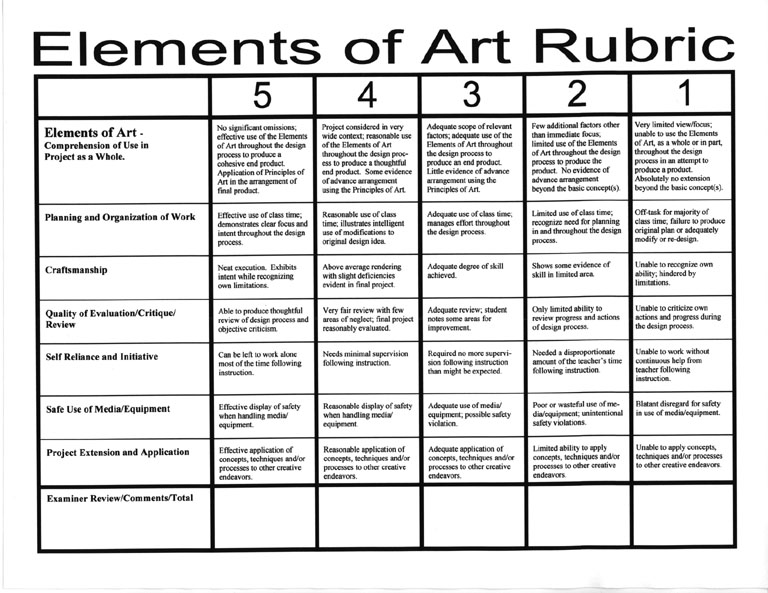 Rubrics are popular assessment tools for many teachers. Like grades and other traditional assessment methods, rubrics fail students.
Rubrics are popular assessment tools for many teachers. Like grades and other traditional assessment methods, rubrics fail students.The problem with rubrics, like letter and number grades, is that they are a one-size-fits-all form of assessment and they are subjective. Rubrics use words like, "seems," "little," "mostly," "adequate," "some" and "weak," to name a few.
Although narrative feedback, the method of assessment that should eliminate grades and rubrics, may use subjective words in some cases, the feedback is far more specific and individualized. If the feedback says, "Very well done overall," this will be followed up with a careful explanation of what was done well. Rubrics don't do this, so even students who meet the learning outcomes don't know how they did it, based on a rubric. Consequently, learning is lost.
For example, on a major project, a part of a rubric may say, "Work displays adequate attention to detail." This statement has virtually no meaning. I'm not sure what "displays" means in this context, and "adequate" is a completely inadequate word in virtually every case. Finally, vague statements like this do not explain what detail the teacher wants.
If providing meaningful narrative feedback, I would mention the detail specifically. If it's a science project on hurricanes, I might say or write something like:
"Your project only partially demonstrates that you understand hot towers, based on the lessons and models from class. You need to add two or more captions to your drawing, explaining how the towers power the hurricane. Please make the necessary changes and resubmit."Not only does this feedback specify what is missing, it asks the student to return to the work, make changes and resubmit.
Because a rubric is a one-size-fits-all tool, it does not meet the needs of each individual and, consequently, fails students.
Rubrics, if student-created, can be useful; however, the ground rules need to be solid. Everything mentioned in a student-created rubric needs to be countable or a visual yes/no situation. You can't count "seems" but you could quantify much of what we want students to include or exclude from their writing. (Linda Knappett)
ReplyDeleteLinda, I like the idea of student self-evaluations. I much prefer that they use the same kind of narrative feedback that I provide, though. I just don't believe that a "yes" and "no" response says much about what was or was not learned.
ReplyDeleteThanks for reading and for your thoughts.
Mark, what are your thoughts about a rubric as a pre-assignment outline of expectations, where detailed, narrative feedback is provided, on the completed assignment?
ReplyDeleteLori, although I certainly understand your thinking on this and believe it could be useful, it just seems like an unnecessary step to me. I feel like my guidelines for activities/projects take care of this step, and the ongoing narrative feedback does the rest.
DeleteIsn't this very dependent on you though?
DeleteProviding guidelines is dependent on me, because I have to create them. However, they are driven by the work my students complete and the feedback they give me.
DeleteI use rubrics regularly with very specific outcomes. I avoid vague terms like 'good', 'well', 'interesting' etc and look for the measurable outcomes, sometimes including other learners' reactions to the product as part of the assessment.
ReplyDeleteThe reason I would be hesitant to throw rubrics out the window is that the learners use them to set their own personal targets and they can concretely judge how they are doing through self and peer assessment. They are rarely summative (except for external exams).
Am I right in thinking that a checklist is what you give to learners so they can see if they are on track? (Your recent 'no grades' presentation on ASCD seemed to imply this.) If so, how do the learners know the 'next step' independently of you. Through my rubrics, the learners can place their work and rubric side by side to judge where they are and if unsure can ask one of their peers, thereby removing me from the process until they feel they have gone as far as they can.
I am not challenging you; I am genuinely curious as to why you see rubrics as totally pointless. (Maybe I just need to see an example of your guidelines?)
I should probably mention that my learners co-construct rubrics with me before we start any work, so they have as much ownership as possible, and we most likely do this through deconstructing what we agree are useful models for us to use as inspiration.
DeleteAbena, thanks for your detailed comments. When I mentioned a checklist in my ASCD presentation, I meant that I was providing a checklist of project choices, as well a to-do list, which they do indeed place side-by-side with their work product. In this way, I suppose my guidelines are similar to your rubric.
DeleteI simply prefer the detailed feedback, using the SE2R system that I presented in my webinar. I've had the rubric debate with some very intelligent teachers, who I believe make it work, because they are dedicated to their craft. Perhaps if I rewrote this post, I might qualify some of the statements.
Better still, perhaps you'd be interested in creating the debate her on the Role Reversal blog with a guest post, demonstrating what an effective rubric looks like. If you are interested, email me at mark@thepaperlessclassroom.com.
Thanks again for chiming in.
You've got mail! :)
Delete